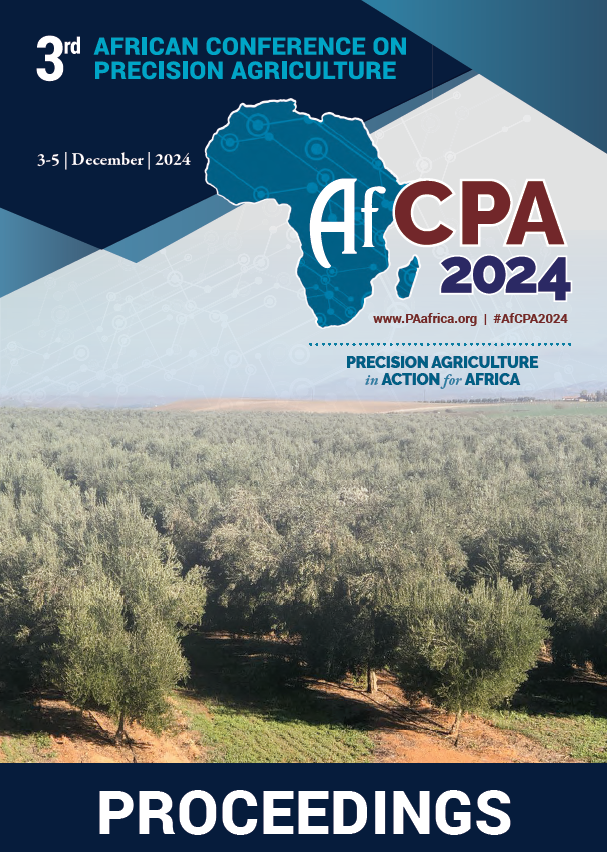Download the Conference Proceedings
Proceedings
Authors
| Filter results9 paper(s) found. |
|---|
1. Estimating soil organic carbon from cell phone imagesSoil organic matter (SOM) is considered as the backbone of soil health and soil quality. Thus, its’ estimation is critical to support the development of management decision including precision agriculture. To overcome challenges of laborious, rather expensive and time-consuming laboratory measurements, recent advances in image acquisition systems provided a new dimension of image-based SOM prediction. However, challenges remain in using soil images taken directly in the field due to variable... A. Biswas, Y. Fu, P. Taneja, S. Lin, P. Daggupati, H. Vasava |
2. Spectral assessment of chickpea morpho-physiological traits from space, air and groundChickpea (Cicer arietinum) is an important grain legume in semi-arid regions and water-stress is a major constraint to its productivity. Area under chickpea cultivation is growing but climate change toward greater aridity results in higher precipitation instability and risks yields. The ability to assess water potential can support irrigation decisions. Thus, improved ability to spatially assess plants water status can promote more efficient irrigation. The current... I. Herrmann, R. Sadeh, A. Avneri, Y. Tubul, R. Lati, S. Abbo, D.J. Bonfil, Z. Peleg |
3. Soil fertility mapping of Dry savannah zone of TogoIncreasing agricultural productivity and therefore the production requires a good knowledge of the soil fertility status and a sustainable nutrients management. The objective of this study is to map spatial distribution of some selected soil fertility parameters in the dry savannah agro-ecological zone that covers the regions of Savanes and Kara in Togo. Soil fertility parameters such as pH, available phosphorus (P), exchangeable potassium (K) and organic matter were determined in soil samples... K.K. Ganyo, K.A. Ablede , K. Koudjega, S. Ani, K. Afawoubo, D.A. Anoumou, A.T. Mensah, E. Assih-faram, M. Tchalla-kpondji, K. Kpemoua, Y. Lombo |
4. Small Machinery for Sustainable Intensification of Crop-Livestock System under Biomass ShortageSmall crop-livestock systems in Low- and Middle-Income Countries (LMIC) such as North African ones are characterized by low mechanization levels, thus undermining their productivity and sustainability. Machinery being promoted in local markets are made and imported mostly from industrial countries where farm systems are larger in terms of size. Prices of these machines are not affordable for small to medium sized land-holding farmers who remain incapable of upgrading and modernizing their farming... U. Rudiger, Z. Aidoudi, A. Frija, M. Rekik, A. Zaiem, H. Cheikh |
5. Decision Support System in AgricultureDescriptive integrated models for water resource management are not limited to hydrological variables, but integrate environmental socio-economic subsystems and study the interactions and feedbacks between the various interacting subsystems. Agriculture is a major water resource management sector that takes economic factors into account. In dynamic system models, we try to look for the optimal economic policies to achieve sustainability by introducing... |
6. Water Application Efficiency of an Ultisol in Response to Climate Change in Two Agroecological Zones of NigeriaIrrigation and fertilizer application are management practices farmers have adopted to increase food production for the growing population. This has improved crop nutrient absorption and the efficiency of fertilizer applied to the soil. This is essential to reduce plant water stress in a climate changing environment. This study investigated and compared water application efficiency under manual sprinkler irrigation with capillary irrigation method on ultisols located in rainforest and derived... I.A. Egbebi, D.J. Oyedele, F.O. Tijani, O.E. Egbebi |
7. A Time Series Investigation to Assess Climate Change and Anthropogenic Impacts on the Degradation of Nile Delta, Egypt.Land degradation risk, status and rate in Nile Delta, Egypt were assessed for a time series using remote sensing data over the past five decades using TM, ETM and OLI. Quantitative deterioration of the area was produced based on the comparative study approach in the integrated weighted sum, weighted overlay and fuzzy model. Where degradation factors were compiled in a raster and each data set scored on a 1 to 5 (very low, low, moderate, high and very high scale). The data sets were then weighted... B. Abdellatif, M.R. Metwalli, M.M. Metwaly, M.A. Abdelrahman |
8. Remote Sensing: from Plot Towards Landscape ScalesThe agricultural research sector is working to develop new technologies and decision support tools to sustainably increase food productivity, ensure global food security and decrease poverty. Precision Agriculture (PA) and specially Remote Sensing (RS) technologies have become more affordable in recent years. Cameras have become more compact and lighter, with improved spectral and spatial resolutions. The use of incoming light sensors allows for images to be automatically calibrated to surface... F. Rodrigues |
9. Design and Development of a LoRa Communication System for Scalable Smart Irrigation SystemsSmart irrigation is a promising tool to optimize irrigation water use but is still faced with challenges related to usability and applicability attributed to several constraints such as high initial costs, complex user interface, poor connectivity, limited farm coverage, etc. This study aimed to solve some of these issues through the development and testing of a LoRa communication system using a Raspberry Pi 4, LoRa HAT concentrator, and Strega smart valve at the Makerere University Agricultural... J. Wanyama , J. Ikabat, I. Kabenge, P. Hess, P. Nakawuka, E. Bwambale , J. Muyonga, S. Felicioni, A. Bühlmann, T. Anken |
